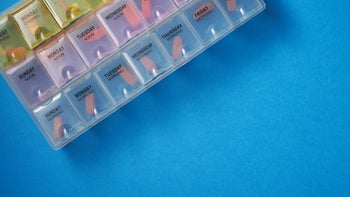
Eligard vs. Lupron Depot for Prostate Cancer: What Are the Differences?
Key takeaways:
Eligard and Lupron Depot both contain the same active ingredient — leuprolide. They both lower testosterone levels and are used for advanced prostate cancer.
Eligard is given as an injection under the skin. Lupron Depot is given as an injection in a muscle.
Eligard is only FDA approved for prostate cancer. Lupron Depot is FDA approved for prostate cancer and other conditions, such as uterine fibroids, endometriosis, and early puberty in children.

Prostate cancer is one of the most common cancers in the U.S. It affects about 1 in 8 men. Prostate cancer happens when unhealthy prostate cells grow without stopping. In some cases, this condition can be difficult to treat.
Advanced prostate cancer is when the cancer has spread to other areas of the body or has returned after being treated. Healthcare providers sometimes treat this type of prostate cancer with hormone therapy. Two hormonal medications that may be prescribed are Eligard and Lupron Depot.
Eligard and Lupron Depot both contain the same medication — leuprolide. While very similar to each other, there are a few differences between the two.
Search and compare options
We’ll explain how leuprolide is used for prostate cancer and compare Eligard and Lupron Depot.
How does the administration of leuprolide affect prostate cancer treatment?
Testosterone is one of the sex hormones in the human body. It’s especially important for the reproductive health of men. Testosterone helps the prostate grow and mature. But prostate cancer cells can also use testosterone to grow. That’s where leuprolide can come in.
Leuprolide belongs to a medication class called gonadotropin releasing hormone (GnRH) agonists. GnRH agonists are sometimes called luteinizing hormone-releasing hormone (LHRH) agonists. These are the same thing.
These medications work by lowering the amount of testosterone the body makes. This cuts off the testosterone supply to the cancer cells.
For the first few weeks, leuprolide can actually raise testosterone levels. This is called a “testosterone flare.” This is a normal reaction while the body adjusts to the medication. Symptoms may worsen during the flare, but they tend to go away after a few weeks.
To combat a flare, healthcare providers can temporarily prescribe a medication to block testosterone’s effects. These antiandrogen medications can help prevent symptoms from worsening. Sometimes these are also called testosterone blockers. Once the testosterone flare is over, your provider will usually recommend that you stop taking the testosterone blocker.
Experts recommend using leuprolide for advanced prostate cancer that uses testosterone to grow. Leuprolide can help relieve pain and other symptoms when the cancer has spread (metastasized) to other areas of the body. This is also called metastatic prostate cancer.
Not all types of prostate cancers are sensitive to testosterone. This is called castrate-resistant prostate cancer. Leuprolide wouldn’t help in this situation.
What are the differences between Eligard and Lupron Depot?
Eligard and Lupron Depot have two major differences — their route of administration and their FDA-approved uses.
Eligard is given as a subcutaneous injection. This means it’s injected under the skin. It’s only FDA approved for advanced prostate cancer.
Lupron Depot is given as an intramuscular (IM) injection. This means it’s injected into a muscle. It’s also approved for advanced prostate cancer. But Lupron Depot is also FDA approved for endometriosis, uterine fibroids (growths in uterine muscle), and early puberty in children.
Since Eligard and Lupron Depot both contain the same active ingredient, effectiveness and side effects are similar. Deciding which one to use often comes down to personal preference and cost.
Are Eligard and Lupron Depot administered in different ways?
Yes. As mentioned above, Eligard and Lupron Depot are both injections. But they’re different types of injections.
Eligard is a subcutaneous injection. It’s administered into the fat cells right beneath the skin. It’s usually injected in the stomach area, buttocks, or back of the upper arm.
Lupron Depot is an IM injection. It’s administered in a muscle and is injected deeper in the body than Eligard. Lupron Depot is injected in the buttocks, hip muscle, outer thigh, or outer part of the upper arm.
It’s important to inject these medications in the right location. IM and subcutaneous injections are absorbed by the body differently. Giving them in the wrong areas could affect how the medications work.
Pain where the medication is injected — injection site pain — is a common side effect for many injectable medications. When compared to each other in a small study, both medications were well-tolerated. But participants using Eligard reported injection pain slightly more frequently than those using Lupron Depot. Both Eligard and Lupron Depot come in the following doses for advanced prostate cancer:
7.5 mg injected once a month
22.5 mg injected every 3 months
30 mg injected every 4 months
45 mg injected every 6 months
Can you self-administer Eligard or Lupron Depot?
It’s not recommended to self-administer Eligard or Lupron Depot. These medications must be mixed right before they’re injected. To help make sure the medication is properly prepared, a healthcare professional should give you your dose.
If you find certain injection areas are more uncomfortable than others, let your provider know. If it’s difficult to get to your provider’s office, discuss the available doses. As mentioned above, Eligard and Lupron Depot both have the option of twice-yearly doses.
Eligard vs. Lupron Depot: Which is more effective against prostate cancer?
There isn’t much research available comparing these medications directly. But we can look at how well each medication lowers testosterone levels.
The goal with medications like leuprolide is to lower testosterone levels below 50 ng/dL. In Eligard’s clinical trials, over 94% of participants achieved this goal within about a month of their first injection. Similarly, about 94% of people in Lupron Depot’s clinical trials reached the goal level within the first month.
Based on this information, we can say Eligard and Lupron Depot are comparable.
What are the side effects of Eligard vs. Lupron Depot?
Side effects for Eligard and Lupron Depot are similar. This is because they both contain the same active ingredient — leuprolide.
Specific side effects can vary depending on your dose. But common side effects of Eligard and Lupron Depot include:
Dizziness
Fatigue
Hot flashes
Injection site pain
Sexual problems, such as erectile dysfunction and low sex drive
Leuprolide also has some long-term risks and side effects. While these may be expected, they can lead to other medical issues. Your healthcare provider should be watching for these with regular blood tests and exams.
Long-term side effects for Eligard and Lupron Depot include:
Bone loss
High blood sugar and a higher risk of diabetes
Higher risk of heart attacks and strokes
Higher risk of seizures, especially for those who have seizure conditions
Make sure your healthcare provider is aware of all medical conditions you have before starting Eligard or Lupron Depot. This will help them better monitor for these side effects. Discuss any concerns about these risks with your provider.
Do Eligard or Lupron Depot affect the immune system?
No. Neither Eligard nor Lupron affect the immune system. They’re a form of hormone therapy and don’t affect the bone marrow like chemotherapy.
How to save on Eligard and Lupron Depot
Eligard and Lupron Depot are only available as brand-name medications. But GoodRx can help you navigate ways to save on your prescription.
Save with patient assistance programs. If you’re uninsured or underinsured, you may be eligible for the Eligard or Lupron Depot patient assistance programs, which offer the medication at no charge.
Save with a copay savings card. If you have commercial insurance and meet eligibility requirements, Lupron Depot’s price is as little as $10 if you use the manufacturer’s savings card.
The bottom line
Both Eligard and Lupron Depot can be used for advanced prostate cancer. These two brand-name medications contain the same ingredient — leuprolide. They’re similarly effective and carry the same side effects.
The biggest difference between Eligard and Lupron Depot is how they’re given. A discussion with your healthcare provider about cost, dose timing, and personal comfort level with injections can help you make a decision between the two medications.
Why trust our experts?



References
AbbVie Inc. (2020). Lupron depot [package insert].
AbbVie Inc. (2021). Lupron depot-PED [package insert].
American Cancer Society. (2019). What is prostate cancer?
American Cancer Society. (2021). Hormone therapy for prostate cancer.
American Cancer Society. (2022). Key statistics for prostate cancer.
American College of Obstetricians and Gynecologists. (2020). Uterine fibroids.
Endocrine Society. (2022). Reproductive hormones.
Gomella, L. G. (2009). Effective testosterone suppression for prostate cancer: Is there a best castration therapy? Reviews in Urology.
Gutierrez, J. J., et al. (2021). Intramuscular injection. StatPearls.
Kim, J., et al. (2021). Medication routes of administration. StatPearls.
MedlinePlus. (2022). Subcutaneous (SQ) injections.
National Cancer Institute. (n.d.). Castrate-resistant prostate cancer.
National Cancer Institute. (n.d.). Chemotherapy.
National Cancer Institute. (n.d.). Gonadotropin-releasing hormone agonist.
National Cancer Institute. (n.d.). Testosterone flare.
National Cancer Institute. (2021). Hormone therapy for prostate cancer.
National Comprehensive Cancer Network. (2020). NCCN guidelines for patients: Prostate cancer advanced stage.
Parker, C., et al. (2020). Prostate cancer: ESMO clinical practice guidelines for diagnosis, treatment and follow-up. Annals of Oncology.
Prostate Cancer Foundation. (n.d.). Prostate cancer metastases.
Saltzstein, D., et al. (2017). Pharmacokinetic and pharmacodynamic comparison of subcutaneous versus intramuscular leuprolide acetate formulations in male subjects. Therapeutic Advances in Urology.
Swayzer, D. V., et al. (2021). Leuprolide. StatPearls.
Tolmar Pharmaceuticals, Inc. (n.d.). Getting started on Eligard.
Tolmar Pharmaceuticals, Inc. (2019). Eligard [package insert].

























